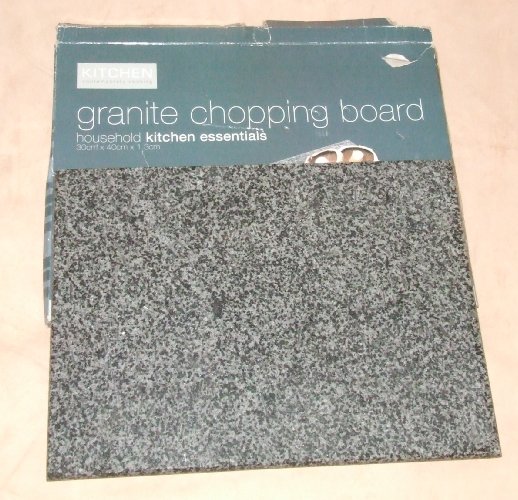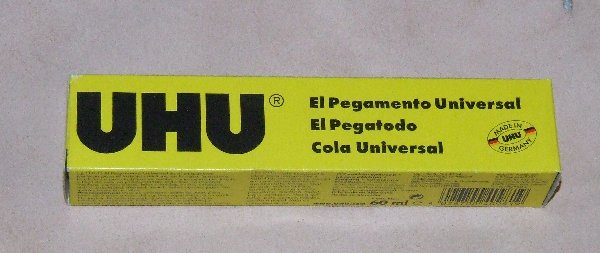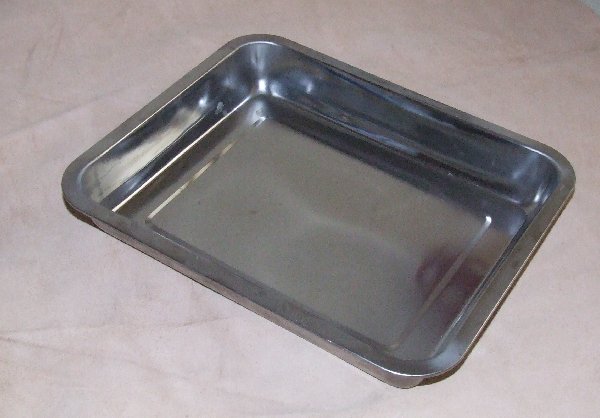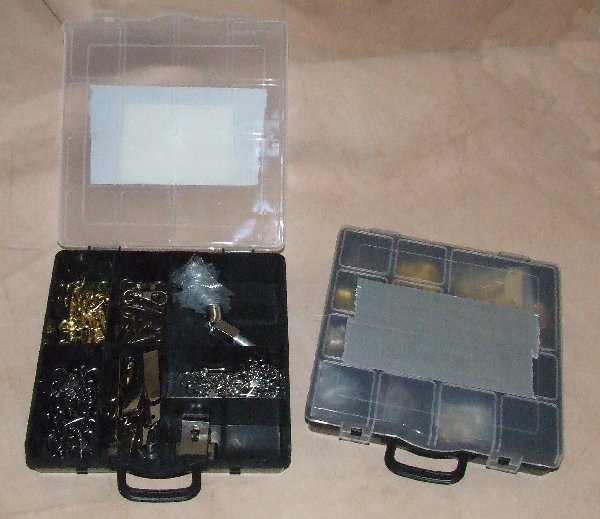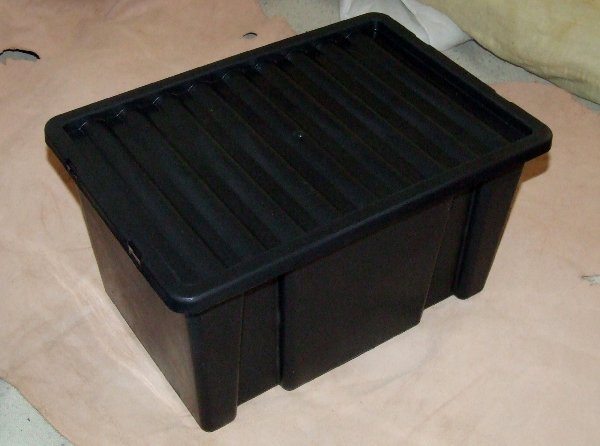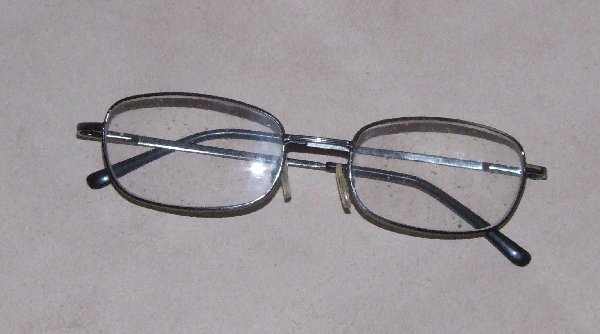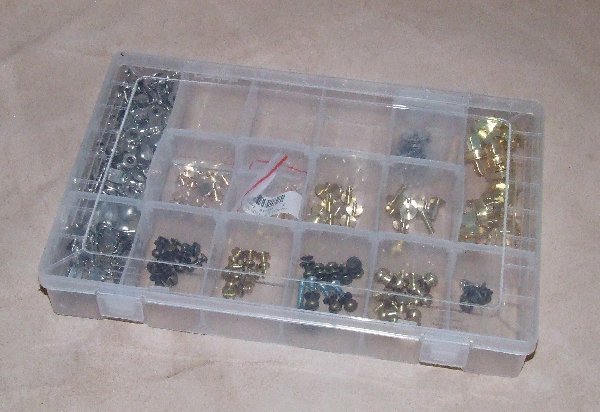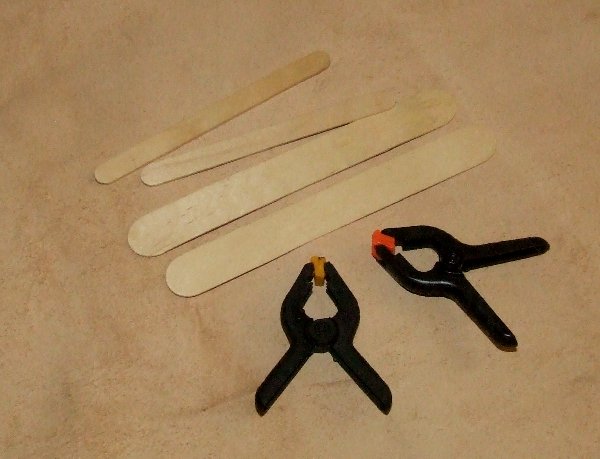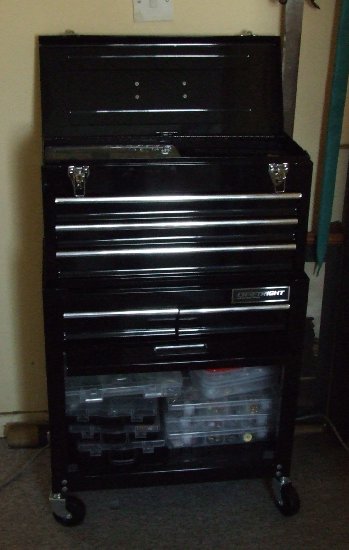-
Posts
5,925 -
Joined
Content Type
Profiles
Forums
Events
Blogs
Gallery
Everything posted by fredk
-
Reason for not being able to get one; probably two - 1. plastic ones are dirt cheap, 2, no-one has thought of making them Ask a general purpose leather worker to make it for you. It could be made up in upholstery leather. But leather has a finite size so the cover will have to be sewn up in two or three sections for the top depending on the size of your table
-

Ideas for theft-resistant display for leather dog collars?
fredk replied to lightingale's topic in Leatherwork Conversation
A log, bout 4 inches diameter, covered in nice cloth, like felt or suede. Supported at each end. Buckle collars round it. Have to undo the buckles to get them off. An extra security could be chain link joints; [the ones that are a link shape with a bit that screws from one bar to the other to close it] put thru the buckle parts. Have to undo that, then the buckle to get it off the log, or use a plastic cable tie thru the buckle; just cut and thrw away, easier for sales person maybe -
Okee-doakly; I'm going to give away some leather Yup, free, no strings [or lacing ] attached I'm re-organising my work room and for reasons I'll not go into I have far too much leather. Much too much Here's the plan; I'll give it away Today I want to assess interest. I've not sorted out what is to go yet. But we ain't talking 6 inch square waste, we're talking some decent square footage However what is to go is pre-dyed in odd colours, some may have a pattern imprinted into it. I reckon most is chrome tanned, some might be veg tanned, but I'don't know either way. It was all bought from Le Prevo, mostly out of their 'special offers' list How do you get it from me? A. if you're in Ireland you need to drive to Dungannon in Co. Tyrone [don't go heading to Duncannon in Wexford like some eejits I know! ] B. Scotland/England/Wales; I'm heading to Telford in Shropshire in November [thats a long time away, but I'm slow in the sorting bit, ] I plan to get the ferry to Scotland then drive down, making stops along the way. Thus you can meet me along the route. Warning; I'll be arriving in Scotland at o'silly o'clock in the morning cos I want to be in Northumberland for about 9am As I sort out what is to go I'll post up details and a photo or two of each bit. Who gets what; first to ask gets it but if they fail to arrange collection it goes to the next asker - ok? So youse can fight it betwixt yerselfs so yez can I'd prefer a few people each takes some rather than just one person Expressing an interest now is not a formal commitment; only when yez knows whats on offer - this is just to find if any of youse are interested so I know I can bother sorting it out and not just bung it all back into my storage. Offer to those in the UK or Ireland only
-
First off; get the problem sorted under warranty. If you attempt anything now it will invalidate your warranty completely which may be needed if another problem shows up Then with that done work on how to prevent it happening again
-
I think its too far gone. A feeding as YinTx suggests then retire it to a display as an exhibit. I find that often people forget that leather is flesh, it will eventually rot away. It will last a long time if looked after, but if not it'll rot away as fast as any dead body.
-
W70 DT in the list http://www.leprevo.co.uk/buckles-steel.htm
-

Putting nylon webbing inside of folded leather straps
fredk replied to Anubis78's topic in Sewing Leather
A few random thoughts: A; I have nylon straps on things from about 1970, so longevity isn't a problem B; if you glue the nylon to the leather it might stabilise the leather, ie as the nylon won't stretch neither will the leather attached to it. It might stengthen the thin leather C; if the leather is very thin and the nylon has a coarse weave that weave pattern might eventually show through on the outside- 7 replies
-
- folded leather straps
- nylon webbing
- (and 3 more)
-
I use loads of the small office bulldog clips as well, with the lolly sticks. For a thinner stick is a McDonalds [not the farmer chappie - the fast 'food' place] stirring stick. I do not advocate taking a big load from them as that is stealing, but an extra one or two every time you're in and you'll soon have several hundred...... I thank Blue Peter. John, Peter, Val et al. They say you can age someone by who their favorite BP presenters were and their fav Dr. Who. I confusethose who want to know my dob with; fav Dr. Who is Patrick Troughton and for BP its Konnie Huq Sticky back plastic rules!
-
A. my upholstery leather is soft and is about 1mm thick, 1.5mm maximum. I handsew it all the time just using a glovers needle. Thread is 0.5mm or lighter. Only when I double it up do I use a chisel or punch first B. On some bags I've glued the upholstery leather, two pieces flesh side to flesh side, sandwiching a bit of compressed cardboard in between for ridgity. No problem doubling it with whatever you choose to do with it.
-
yes, the edges on the Tandy letter blocks aren't finished off too well. I file off the roughness with a coarse metal file. The press will make a real difference though
-

Help - I think needle broke off in 29k58 needle holder
fredk replied to ELeBlanc's topic in Leather Sewing Machines
try a powerful magnet -
Is it keeping the Tandy letters in alignment that is a problem for you? They sell a frame to help with that, or as I did, made one for myself from perspex and small bolts As I said I have several Tandy letter sets, from 1/4 inch to 3/4 inch in size. I could never afford to buy each letter made individually in brass. And the frame works with them all Or is the problem getting a good impression? I've just invested in a press and the Tandy letter set adapters - world of a difference to whacking with a mallet
-
1. buffing after dyeing; removes excess dye. First couple of times buffing removes obvious excess, continued buffing removes excess which may still come to the surface. For this, use a light coloured cloth, changing the surface frequently. Once the cloth shows absolutely no colour on it from the dye its buffed enough 2. buffing after final finish; after putting on a bee'swax mixture, the heat generated by buffing helps melt the beeswax mix into the leather fibres, it also helps to compress the surface fibres to make it smoother. First couple of times just gets that mix into the leather, the next few times smooths the leather and starts to bring up the shine
-
For letters I just use the Tandy sets. I have several sets in different fonts. Some need to be searched out as old stock in dealers as Tandy seem to regularly discontinue fonts. For 3mm size letters I have a set meant for stamping code numbers for vehicle VIN Photo engraving is better known here as photo etching. Le Prevo offers a photo engraving service to make stamps in magnesium. Costs £2.54 per square inch, £50.40 minimum charge [both prices plus delivery and VAT on it all] I got some large designs done by them. Not overly happy with them. The photoengraving 'cuts' at an angle outwards from the original artwork line so that the image when stamped doesn't have a really sharp outline, unlike CNC cut brass stamps I looked for photoengraving/etching in the UK as well, most who does this only does electronic circuit boards; some who offered 'photo etching of anything' wouldn't even consider doing it to make anything but, some didn't bother answering my enquiry
-

First Axe Mask completed
fredk replied to KurseD's topic in Gun Holsters, Rifle Slings and Knife Sheathes
A; first off we can't really make any leather water-proof but only shower-proof b, you said above that you were going to spray the Resolene on. It will take several coats by spraying. Spraying puts on very thin coats. You may need two just to seal the dye. Then maybe four or five more. I dip if I can, or apply with a brush or sponge usually - first coat to seal and then two more is usually suffcient -
There have been a few threads about cutting costs or getting stuff cheap but they were by and for the US cousins so I thought I'd start one for the UK-ers I can't see anywhere else but here to run the thread 1. Granite chopping board. From Home Bargains = £4.99, exactly the same one sold by Argos is £9.99. Size is 40 x 30 x 1.3 cm. It may be thin but I've been stamping on it and it hasn't cracked yet. Certainly good enough for edge skiving if you don't want to chance the stamping on it 2. Next we visit the Poundland shop, so all these items cost.... ?? How much? anyone? Bueller? UHU glue. Look for the solid box. There is one with a window in the box, that tube is far smaller [half the contents afair]. Its a good contact glue, Easy to apply because it is a tube - and in my case you don't waste a load cos the rest of the glue in the tin has solidified. UHU is also available at some Home Bargains for... 99p a tube. Home Bargains sells a Bostick type glue in their own brand name; its good too, at £1 a tube. 3. Stainless steel roasting tin. I use these for dip dyeing. Holds enough dye and easy clean up 4. Compartment storage box, About 20 x 20 x 4cm. Divided up into twelve 5 x 5cm and one 10 x 10cm sections. Many of the partitions are removable making the areas longer [or wider, but not both ways]. Handy for keeping and segregating small things like small rivets, Chicago screws or Sam Browne buttons 5, Black box with lid.This one is just under the size of half of a folding crate. I throw scraps into a number of these, then sort out the stuff that can be used from the real waste. I make board games so any piece from which I can punch a 6mm disc is still good for me 6. Need to see better close up? I wear reading glasses. Available in powers from 1 D to 4 D. I have several in 2, 2.5, 3 and 3.5 powers for various tasks [not all leather work] They're cheap enough to have several pairs kicking around. My eye specialist [I can't spell her fancy title!] put a pair on one of her machines and she said the lenses were fine; almost as good as the ones she gets for customers. 7. A new style of reading glass on the block. With LED lights, one each side. I'm still checking these out. In low light they help but if you have bright working lights they don't seem to make much difference. These cost me £1.09 from China via ebay 8. Back home - to Home Bargains actually. A medium sized clear storage box, £1.69. I keep things that I use more frequently in these as I can see the contents better 9. At many discount stores; small spring clamps, usually about £1 to £1.50 for six or eight. Their jaws will mark leather so I use lolly sticks between the jaws and the leather, both sides. Not only does this prevent the leather from getting marked but it spreads the clamping force. And, yes occasionally the stick will leave a flat impression on the leather but it never looks bad. Normal lolly sticks at The Works; 50 for £1, or some craft stores 100 for £1, and wide sticks; 100 for about £1.50 Don't use the coloured sticks; the colour comes out and will stain the leather, it even stained some chrome tanned upholstery leather I have. 10 Another bargain. I'm currently 'remodeling' [ahem....clearing out, tidying, sorting the mess of, or as we say here 'redding it out' ] the room I do leather work in. I went to Homebase to look for another tool box and got this; £40, discounted from £160. It was a stock clearance sale. It pays just to keep yours eyes and ears open. I already had two drawer units [the top bit of this] from Halfords for my tools. Sometimes they discount the tool boxes too. Right, that's all from me for now. Over to youse.........
-

A knife needed a sheath...
fredk replied to immiketoo's topic in Gun Holsters, Rifle Slings and Knife Sheathes
nah, if she says owt just say you need to have your own cos the other boys won't let you have the lend of theirs and they won't play with you if you haven't got one of your own - like a bowling ball- 14 replies
-
- handstitched
- tigerthread
-
(and 1 more)
Tagged with:
-

A knife needed a sheath...
fredk replied to immiketoo's topic in Gun Holsters, Rifle Slings and Knife Sheathes
You can buy very basic airbrushes for the cost of a couple of magazines. An adapter can let you run it from a car tyre or; secondhand - can be picked up a spray tanning set up. A basic compressor with basic spray brush or two. I got a spray tan set 2nd hand 12 years ago for $10, compressor still working and does a good job. Thats loverly bit of work there immiketoo- 14 replies
-
- handstitched
- tigerthread
-
(and 1 more)
Tagged with:
-

First Axe Mask completed
fredk replied to KurseD's topic in Gun Holsters, Rifle Slings and Knife Sheathes
Make sure your dye is really dry. Buff off any excess. Apply a thinned coat of Resolene [1 Res to 1 water]; let that dry completely. It'll lock the dye in. Subsequent coats of Res [also thinned] should not lift the dye colouring then -
Many years ago a young artist I was working with said something which I carry through even yet. She liked to paint very modernist work, but week after week she painted people and pet portraits. I asked her about this. She said for every portrait she did she got more funds for doing the painting she really wanted to do. I follow this thru by making small items in upholstery leather [No, I don't scavenge]; these I sell at modest prices, profits go towards buying the more expensive leathers or tools for the higher priced range of goods.
- 11 replies
-
- saving lots o money
- storage
- (and 6 more)
-

Mexican loop question
fredk replied to dikman's topic in Gun Holsters, Rifle Slings and Knife Sheathes
A thought; use centre back or shoulder for the outside and belly for the lining. Belly will have plenty of 'give' in it, but will stiffen up a lot when it dries out after any wet moulding -

New projects
fredk replied to LeatherLegion's topic in Purses, Wallets, Belts and Miscellaneous Pocket Items
The way Bob has shown to do the sewing at the top edge puts less strain on the top hole of the leather. I've seen items sewn with the thread not like that and the first couple of holes have torn like perforations on the edge of a stamp -

Mexican loop question
fredk replied to dikman's topic in Gun Holsters, Rifle Slings and Knife Sheathes
dang, those are real beauties...



